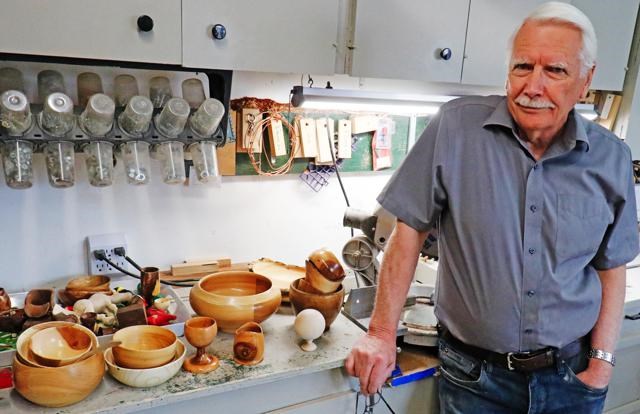Wood-working has turned into a serious passion for former senior public health inspector Grant Paulson, and he shared his hobby in a presentation to members of the Weyburn Rotary Club on Thursday via Zoom.
Paulson has been a wood carver for many years, along with a group of other carvers who regularly met at the Weyburn Public Library, until the COVID-19 pandemic put an end to those gatherings.
Due to the lack of opportunity for the wood carving group to meet, he has been doing more projects on his wood lathe lately, and has been dedicating more time to this style of wood-working in his home shop.
“I’ve always enjoyed working with wood and making stuff,” he explained, noting he first bought a second-hand lathe some 40 years ago when he and wife Nancy lived in Swift Current, but it wasn’t a very good quality lathe.
About a decade ago, a friend in Weyburn, Stan Sampson, asked if he wanted to buy his lathe, and it was a much better quality piece of equipment.
“I didn’t use it too much until my first retirement. I joined the South Saskatchewan Wood-Turners Guild in Regina. They’re a good bunch of guys,” he said, and through this group of around 100 members he’s been able to learn a lot about wood-turning.
Prior to the onset of COVID, the guild would have nights when they would set up several lathes and teach those interested various techniques for turning wood.
“You learn a lot and you try to do a little bit better. That was one of few smart moves in my life to join that outfit,” said Paulson, chuckling. “It’s been really rewarding.”
One of the projects the wood-turning group has taken on is producing wooden bowls for the “Beads of Courage” program, which is in hospitals across Canada for children requiring critical or long-term care, such as for cancer patients.
“Every time a child has a treatment or a stay overnight, they get a bead for that, with different coloured beads for meals, for treatments or for giving blood samples. Some of these kids end up with hundreds of beads, so what our club is doing is making a bowl with a lid on it for these kids to put their Beads of Courage in,” explained Paulson.
Once they were sure the Regina hospitals had all the bowls they needed, the club began sending more to Calgary hospitals, said Paulson, noting one member in particular has made over 100 bowls.
“It’s pretty much a full-time job for him,” he added.
The guild had a workshop on making bowls just before COVID hit, and this encouraged him to try making more.
“When my granddaughter was quite young, she was diagnosed with diabetes, and was in hospital where she had a number of blood tests, needles and shots, and she accumulated quite a number of Beads of Courage,” said Paulson, noting he made her a bowl for collecting the beads.
One bowl he made was from a piece of wood salvaged from an old piano. Paulson noted that former teacher Jackie Wilson had a piano over 100 years old in her basement, but it would cost some $800 for movers to take it out of her house, so she enlisted the help of her brother, Randy Bangsund, to come and take it apart.
Bangsund called Paulson as he found a large thick beam in the piano used for pinning the strings, and Paulson brought it home to use for wood-working.
He was pleasantly surprised to find the wood was a laminated block with different pieces together.
“All these pieces of wood are all laminated together and fit together just perfectly,” he said, noting the wood had a wonderful grain to it. He made a couple of bowls from it, giving one of them to Wilson.
Showing different projects he has made, Paulson noted that wood from fruit trees often have the prettiest grain, as does wood from caragana bushes, but it’s difficult to find good pieces of caragana as it tends to split down the middle when it grows too big.
Asked if he can use green or freshly-cut wood, Paulson said he could, but for a piece of wood to hold its shape after being carved or turned on a lathe, he needs to let it sit and cure for three or four months first.
For safety measures, he wears a mask that has a filter to keep the dust out of his eyes and lungs, plus he has a dust collector that ventilates dust from his shop.




